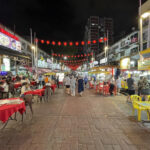Emeryville, California, once an old industrial town, underwent a significant transformation in the 1990s and early 2000s, blossoming into a vibrant mixed-use urban center. This revitalization was driven by numerous development projects and community enhancements, adding thousands of housing units and over a million square feet of commercial space to the city. Among these transformative developments, the arrival of IKEA on Shellmound Street stands out as a landmark, significantly shaping the retail landscape of Emeryville and attracting visitors from across the region.
Emeryville’s journey from its industrial past to its modern present is a compelling story of urban renewal. Following the 1989 Loma Prieta earthquake, the region faced the need for updated infrastructure and new development. While nearby Oakland grappled with its own station plans, Emeryville seized the opportunity to build a new Amtrak station. Constructed on the former Chevron asphalt plant site by Wareham Development, the Emeryville Amtrak station quickly became a major transportation hub, serving over half a million passengers annually and ranking as the 5th busiest in California. This transportation hub spurred further development in the surrounding area.
Wareham Development expanded around the Amtrak station, creating the “Emery Station” complex, featuring residential buildings like the Terraces and office/laboratory buildings such as Emery Station I, North, and East. These buildings attracted cutting-edge biotech companies, including the Ernest Gallo Research Institute and Bayer HealthCare Pharmaceutical, establishing Emeryville as a hub for innovation. Even the California Institute for Regenerative Medicine initially made its home in Emery Station I, highlighting Emeryville’s growing prominence.
Further south, along Shellmound Street, a similar transformation was taking place. The former Santa Fe railroad yard, once abandoned, became the focus of ambitious redevelopment plans. Early proposals for a massive business park eventually gave way to the “East Bay Bridge” regional shopping center. This project, requiring collaboration between Oakland and Emeryville, was approved in 1993 and brought major retailers like Pak ‘n Save and Home Depot to the area. The subsequent development of the Bridgecourt Apartments added a residential component, further diversifying the area.
The arrival of IKEA in Emeryville in April 2000 marked a pivotal moment in the city’s retail evolution. The Swedish home furnishing giant selected the old Judson Steel property on Shellmound Street for its first Northern California store. This location, straddling the Oakland-Emeryville border, required approvals from both cities. IKEA’s opening exceeded all expectations, drawing massive crowds and generating significant traffic, a testament to its popularity and the accessibility of the Shellmound Street location, enhanced by the 40th-Shellmound extensions. The immediate success led to the construction of a parking garage in 2001 to manage the overwhelming demand. While the opening of subsequent IKEA stores in the region has eased some traffic, IKEA Emeryville on Shellmound Street remains a major retail destination, especially during sales events.
North of IKEA, the “South Bayfront Mixed Use Project” further transformed Shellmound Street and the surrounding area. Madison Marquette developed “Bay Street Emeryville,” a large retail and residential complex, featuring 325,000 square feet of retail space, a movie theater, residential units, and a hotel. Opened in November 2002, Bay Street brought in major national retailers like Barnes & Noble and Apple, solidifying Shellmound Street as a premier shopping destination. The addition of residential units above the retail spaces created a new neighborhood and marked the first residential development west of the railroad tracks and south of 65th Street.
Beyond Shellmound Street, Emeryville’s redevelopment extended throughout the city. Former industrial properties were repurposed for commercial and residential use. The Watergate complex saw the completion of its final office tower. The North Bayfront area welcomed hotels like the Woodfin Hotel and apartment complexes like Avenue 64. The North Hollis area saw the renovation of industrial buildings into office complexes like Emery Tech and residential projects like Oliver Lofts. South of Powell Street, old industrial buildings were transformed into condominiums and office spaces. The Park Avenue District saw the Emeryville Warehouse building converted into residential lofts and commercial space, alongside new townhouse and apartment projects. Along San Pablo and Adeline Streets, former bakeries and factories became loft apartments and senior housing.
Emeryville also prioritized green spaces as part of its urban transformation. From its first small park in 1976 to the extensive marina park, the city added numerous parks including Temescal Creek Park and Shorebird Park. Novartis created the public Hollis Green park, and Doyle Hollis Park was under construction. The Emeryville Greenway, a linear park and bicycle path along old railroad lines, became a popular amenity, enhancing the city’s appeal and walkability.
Art and culture became integral to Emeryville’s civic identity. Artists, drawn to the city’s industrial spaces, formed cooperatives like the 45th Street Artists Cooperative. The annual Celebration of the Arts became a city-sponsored event. A public art ordinance in 1990 ensured that new developments incorporated public art, enriching the urban environment.
Emeryville’s commitment to education is evident in its fiercely independent school district. Despite facing challenges in the early 2000s, the Emery Unified School District rebounded through community support and effective leadership, becoming a model for local control and educational improvement.
The city government also evolved to meet the needs of a growing and modernizing city. The new Civic Center, completed in 2001, provided a centralized location for city administration, symbolizing Emeryville’s commitment to efficient and accessible governance.
IKEA Emeryville on Shellmound Street is more than just a retail store; it is a symbol of Emeryville’s remarkable transformation. From its industrial roots to its current status as a thriving urban center, Emeryville’s journey is marked by strategic development, community engagement, and a forward-looking vision. Shellmound Street, anchored by IKEA and Bay Street, stands as a testament to this successful urban revitalization, offering a vibrant mix of retail, residential, and recreational opportunities for residents and visitors alike.

